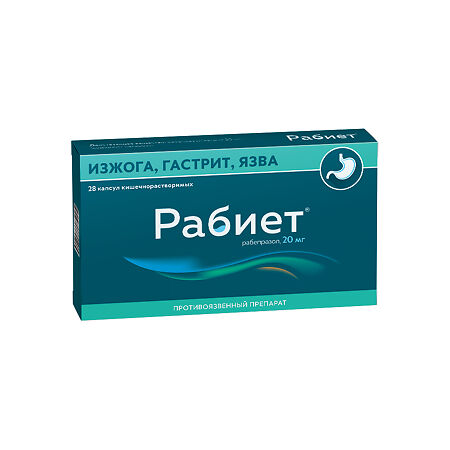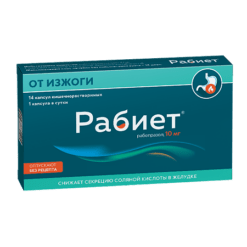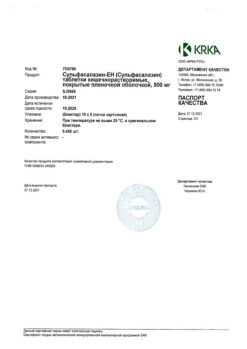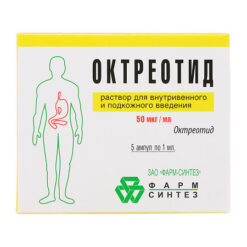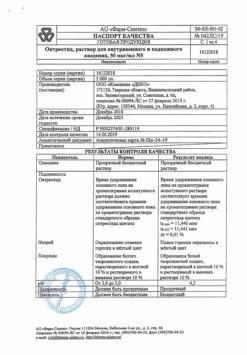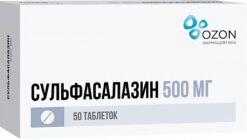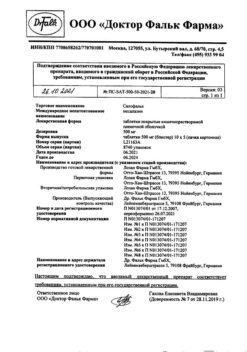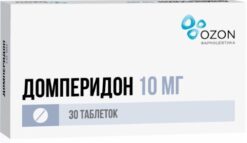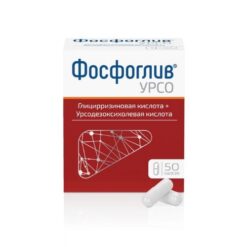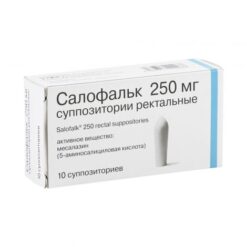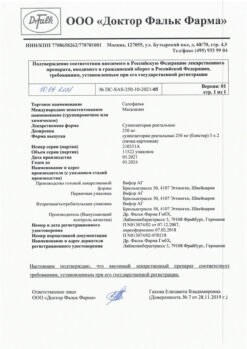No products in the cart.
Rabiet, 20 mg 28 pcs.
€18.66 €15.55
EAN: 4605077010271
SKU: 274723
Categories: Medicine, Stomach, intestines, liver, Ulcer and gastritis
Description
Pharmacotherapeutic group
A gastric gland secretion reducing agent – proton pump inhibitor.
The ATC code: A02BC04
Pharmacological properties
Pharmacodynamics
Mechanism of action
Rabeprazole sodium belongs to the class of antisecretory compounds, benzimidazole derivatives. Rabeprazole sodium inhibits gastric juice secretion by specifically inhibiting H+/K+ ATPase on the secretory surface of gastric parietal cells.
H+/K+ ATPase is a protein complex that functions as a proton pump, thus rabeprazole sodium is a proton pump inhibitor in the stomach and blocks the final stage of acid production.
This effect is dose-dependent and results in suppression of both basal and stimulated acid secretion regardless of the stimulus. Rabeprazole sodium has no anticholinergic properties.
Antisecretory effects
After oral administration of rabeprazole sodium at a dose of 20 mg, the antisecretory effect develops within 1 hour. Inhibition of basal and stimulated acid secretion 23 hours after the first dose of rabeprazole sodium is 69% and 82%, respectively, and lasts up to 48 hours.
This duration of pharmacodynamic action is much longer than that predicted by the half-life (T½) (approximately 1 hour). This effect may be explained by prolonged binding of the drug substance to H+/ K+ ATPase of gastric parietal cells.
The magnitude of the inhibitory effect of rabeprazole sodium on hydrochloric acid secretion reaches a plateau after three days of taking rabeprazole sodium. When discontinued, secretory activity is restored within 1-2 days.
The effect on plasma gastrin levels
In clinical trials, patients took 10 or 20 mg of rabeprazole sodium daily for a treatment duration of up to 43 months. Plasma gastrin concentrations were elevated in the first 2 to 8 weeks, reflecting an inhibitory effect on acid secretion. Gastrin concentrations returned to baseline levels usually within 1-2 weeks after discontinuation of treatment.
The effect on enterochromaffin-like cells
. No consistent changes in the morphological structure of enterochromaffin-like cells, severity of gastritis, frequency of atrophic gastritis, intestinal metaplasia or spread of Helicobacter pylori infection were found in human gastric biopsy samples from the antrum and fundus of 500 patients who received rabeprazole sodium or a comparison drug for 8 weeks.
In a study involving more than 400 patients receiving rabeprazole sodium (10 mg/day or 20 mg/day) for up to 1 year, the incidence of hyperplasia was low and comparable to that of omeprazole (20 mg/kg). No cases of adenomatous changes or carcinoid tumors observed in rats were reported.
Systemic effects of rabeprazole sodium on the central nervous system, cardiovascular or respiratory systems have not been detected at this time.
Rabeprazole sodium has been shown to have no effect on thyroid function, carbohydrate metabolism, blood concentrations of parathyroid hormone, and concentrations of cortisol, estrogen, testosterone, prolactin, glucagon, follicle stimulating hormone (FSH), luteinizing hormone (LH), renin, aldosterone and somatotropic hormone when taken orally for 2 weeks.
Pharmacokinetics
Intake
Rabeprazole is rapidly absorbed from the gut, and its maximum plasma concentrations are reached approximately 3.5 h after a 20 mg dose. Changes of maximum plasma concentrations (Cmax) of the area under the curve “concentration-time” (AUC) of rabeprazole are linear in the dose range from 10 to 40 mg.
The absolute bioavailability after oral administration of 20 mg (compared to intravenous administration) is approximately 52%. In addition, bioavailability does not change with repeated administration of rabeprazole. In healthy volunteers, the plasma elimination half-life is about 1 h (varying from 0.7 to 1.5 h) and total clearance is 3.8 ml/min/kg.
In patients with chronic liver damage, the AUC is doubled compared to healthy volunteers, indicating decreased first-pass metabolism, and the plasma elimination half-life is increased by 2-3 times. Neither the time of intake of the drug during the day, nor antacids affect absorption of rabeprazole.
Ingestion of the drug with fatty foods reduces absorption of the drug by 4 hours or more, but neither Cmax nor the degree of absorption is altered.
Distribution
In humans, the binding of rabeprazole to plasma proteins is about 97%.
Metabolism.
In healthy people. No unchanged rabeprazole was found in the urine after a single oral dose of 20 mg 14 C -labeled rabeprazole.
About 90% of rabeprazole is excreted through the kidneys, mainly as two metabolites: mercapturic acid conjugate (M5) and carboxylic acid (M6), and in the form of two unknown metabolites identified in the toxicological analysis. The remainder of rabeprazole sodium taken is excreted through the intestine.
The total excretion is 99.8%. These data indicate a small excretion of metabolites of rabeprazole sodium with bile.
The main metabolite is thioether (M1). The only active metabolite is desmethyl (M3), but it was observed in low concentration only in one study participant after administration of 80 mg of rabeprazole sodium.
Terminal stage renal failure
In patients with stable, terminal renal failure who require maintenance hemodialysis (creatinine clearance <5 ml/min/1.73 m2), the excretion of rabeprazole sodium is similar to that of healthy volunteers. The AUC and Cmax in these patients were approximately 35% lower than in healthy volunteers.
The average half-life of rabeprazole is 0.82 h in healthy volunteers; 0.95 h in patients during hemodialysis and 3.6 h after hemodialysis.
The clearance of the drug in patients with renal disease requiring hemodialysis was approximately twice as high as in healthy volunteers.
Chronic compensated cirrhosis
Patients with chronic compensated cirrhosis tolerate rabeprazole sodium at a dose of 20 mg once daily, although the AUC is doubled and Cmax increased by 50% compared with healthy volunteers of the respective sex.
Elderly patients
The elimination of rabeprazole is somewhat delayed in elderly patients. After 7 days of rabeprazole 20 mg administration, the AUC was approximately twice as high and the Cmax increased by 60% compared to young healthy volunteers. However, there was no evidence of cumulation of rabeprazole.
CYP2C19 polymorphism.
In patients with delayed CYP2C19 metabolism, after 7 days of taking rabeprazole at a dose of 20 mg daily, the AUC increased 1.9-fold and the elimination half-life increased 1.6-fold compared to the same parameters in “fast metabolizers,” while Cmax is increased by 40%.
.
Indications
Indications
Symptoms of dyspepsia associated with increased acidity of gastric juice, incl. symptoms of gastroesophageal reflux disease (heartburn, sour belching).
Pharmacological effect
Pharmacological effect
Pharmacotherapeutic group
A drug that reduces the secretion of gastric glands – a proton pump inhibitor.
ATX code: A02BC04
Pharmacological properties
Pharmacodynamics
Mechanism of action
Rabeprazole sodium belongs to the class of antisecretory compounds, benzimidazole derivatives. Rabeprazole sodium suppresses gastric acid secretion by specifically inhibiting H+/K+ ATPase on the secretory surface of gastric parietal cells.
H+/K+ ATPase is a protein complex that functions as a proton pump, thus rabeprazole sodium is an inhibitor of the proton pump in the stomach and blocks the final stage of acid production.
This effect is dose-dependent and leads to suppression of both basal and stimulated acid secretion, regardless of the stimulus. Rabeprazole sodium does not have anticholinergic properties.
Antisecretory action
After oral administration of rabeprazole sodium at a dose of 20 mg, the antisecretory effect develops within 1 hour. Inhibition of basal and stimulated acid secretion 23 hours after taking the first dose of rabeprazole sodium is 69% and 82%, respectively, and lasts up to 48 hours.
This duration of pharmacodynamic action far exceeds that predicted by the half-life (T½) (approximately 1 hour). This effect can be explained by the prolonged binding of the drug to the H+/K+ ATPase of gastric parietal cells.
The magnitude of the inhibitory effect of rabeprazole sodium on the secretion of hydrochloric acid reaches a plateau after three days of taking rabeprazole sodium. When you stop taking it, secretory activity is restored within 1-2 days.
Effect on plasma gastrin levels
In clinical studies, patients took 10 or 20 mg of rabeprazole sodium daily for treatment durations of up to 43 months. Plasma gastrin concentrations were increased in the first 2–8 weeks, reflecting an inhibitory effect on acid secretion. Gastrin concentrations returned to baseline levels usually within 1-2 weeks after cessation of treatment.
Effect on enterochromaffin-like cells
In a study of human gastric biopsy specimens from the antrum and fundus of the stomach of 500 patients treated with rabeprazole sodium or a comparator drug for 8 weeks, no consistent changes were found in the morphological structure of enterochromaffin-like cells, the severity of gastritis, the incidence of atrophic gastritis, intestinal metaplasia, or the prevalence of Helicobacter pylori infection.
In a study of more than 400 patients treated with rabeprazole sodium (10 mg/day or 20 mg/day) for up to 1 year, the incidence of hyperplasia was low and comparable to that of omeprazole (20 mg/kg). There have been no reported cases of adenomatous changes or carcinoid tumors observed in rats.
Other effects
Systemic effects of rabeprazole sodium on the central nervous system, cardiovascular or respiratory systems have not currently been detected.
It has been shown that rabeprazole sodium, when taken orally 20 mg for 2 weeks, has no effect on thyroid function, carbohydrate metabolism, the concentration of parathyroid hormone in the blood, as well as the concentration of cortisol, estrogens, testosterone, prolactin, glucagon, follicle-stimulating hormone (FSH), luteinizing hormone (LH), renin, aldosterone and somatotropic hormone.
Pharmacokinetics
Suction
Rabeprazole is rapidly absorbed from the intestine and its maximum plasma concentrations are achieved approximately 3.5 hours after administration of a 20 mg dose. Changes in maximum plasma concentrations (Cmax) and values of the area under the concentration-time curve (AUC) of rabeprazole are linear in the dose range from 10 to 40 mg.
Absolute bioavailability after oral administration of 20 mg (compared to intravenous administration) is approximately 52%. In addition, bioavailability does not change with repeated dosing of rabeprazole. In healthy volunteers, the plasma half-life is approximately 1 hour (ranging from 0.7 to 1.5 hours) and the total clearance is 3.8 ml/min/kg.
In patients with chronic liver damage, AUC is doubled compared to healthy volunteers, indicating a decrease in first-pass metabolism, and the plasma half-life is increased by 2-3 times. Neither the time of taking the drug during the day nor antacids affect the absorption of rabeprazole.
Taking the drug with fatty foods reduces the absorption of the drug for 4 hours or more, but neither Cmax nor the degree of absorption changes.
Distribution
In humans, the binding of rabeprazole to plasma proteins is about 97%.
Metabolism.
In healthy people. After taking a single oral dose of 20 mg of 14 C-labeled rabeprazole, no unchanged drug was found in the urine.
About 90% of rabeprazole is excreted through the kidneys, mainly in the form of two metabolites: a conjugate of mercapturic acid (M5) and carboxylic acid (M6), as well as in the form of two unknown metabolites identified during toxicological analysis. The remainder of the rabeprazole sodium taken is excreted through the intestines.
The total elimination is 99.8%. These data indicate a small excretion of rabeprazole sodium metabolites in bile.
The main metabolite is thioester (M1). The only active metabolite is desmethyl (M3), but this was observed at low concentrations in only one study participant after taking 80 mg of rabeprazole sodium.
End stage renal failure
In patients with stable end-stage renal disease who require maintenance hemodialysis (creatinine clearance <5 ml/min/1.73 m2), the elimination of rabeprazole sodium is similar to that of healthy volunteers. AUC and Cmax in these patients were approximately 35% lower than in healthy volunteers.
The average half-life of rabeprazole is 0.82 hours in healthy volunteers; 0.95 hours – in patients during hemodialysis and 3.6 hours – after hemodialysis.
Clearance of the drug in patients with kidney disease requiring hemodialysis was approximately twice as high as in healthy volunteers.
Chronic compensated cirrhosis
Patients with chronic compensated liver cirrhosis tolerate rabeprazole sodium 20 mg once daily, although AUC is doubled and Cmax is increased by 50% compared to sex-matched healthy volunteers.
Elderly patients
In elderly patients, the elimination of rabeprazole is somewhat slower. After 7 days of rabeprazole 20 mg in elderly subjects, the AUC was approximately twice as high and Cmax was increased by 60% compared to young healthy volunteers. However, there were no signs of rabeprazole accumulation.
CYP2C19 polymorphism.
In patients with slow metabolism of CYP2C19, after 7 days of taking rabeprazole at a dose of 20 mg per day, the AUC increases by 1.9 times and the half-life by 1.6 times compared with the same parameters in “rapid metabolizers,” while Cmax increases by 40%.
Special instructions
Special instructions
The patient’s response to therapy with rabeprazole sodium does not exclude the presence of malignant neoplasms in the stomach.
In a special study in patients with mild or moderate hepatic impairment, the incidence of side effects of rabeprazole was not found to be significantly different from that in age- and sex-matched healthy individuals, but despite this, caution is recommended when first using Rabiet® in patients with severe hepatic impairment.
For patients with impaired renal or liver function, dose adjustment of Rabiet® is not required. The AUC of rabeprazole sodium in patients with severe hepatic impairment is approximately 2 times higher than in healthy patients.
Hypomagnesemia
When treated with proton pump inhibitors for at least 3 months, cases of symptomatic or asymptomatic hypomagnesemia have been reported in rare cases. In most cases, these reports were received one year after therapy. Serious side effects included tetany, arrhythmia, and convulsions.
Most patients required treatment for hypomagnesemia, including magnesium replacement and discontinuation of proton pump inhibitors. In patients who will be receiving long-term treatment or who are taking proton pump inhibitors with drugs such as digoxin or drugs that can cause hypomagnesemia (eg, diuretics), magnesium concentrations should be monitored before starting treatment with proton pump inhibitors and during treatment.
Other drugs that reduce acidity, such as H2-histamine blockers or proton pump inhibitors, should not be taken simultaneously with Rabiet®.
Bone fractures
Observational studies suggest that proton pump inhibitor therapy may increase the risk of osteoporosis-related fractures of the hip, wrist, or spine. The risk of fractures was increased in patients receiving high doses of proton pump inhibitors for a long time (a year or more). By high should be understood doses exceeding those recommended in the instructions.
Concomitant use with methotrexate
According to the literature, simultaneous use of proton pump inhibitors with methotrexate (primarily in high doses) can lead to an increase in the concentration of methotrexate and/or its metabolite hydroxymethotrexate and prolong its elimination time, which can lead to methotrexate toxicity. If it is necessary to use methotrexate in high doses, the possibility of temporarily stopping therapy with proton pump inhibitors may be considered.
Clostridium difficile
Proton pump inhibitor therapy may lead to an increased risk of gastrointestinal infections, such as those caused by Clostridium difficile.
Patients taking rabeprazole for short-term symptomatic treatment of symptoms of GERD and NERD (eg, heartburn) without a prescription should contact their doctor if:
– use of medications to relieve symptoms of heartburn and indigestion for 4 weeks or more;
– the appearance of new symptoms or changes in previously observed symptoms in patients over 55 years of age;
– cases of unintentional weight loss, anemia, gastrointestinal bleeding, dysphagia, pain when swallowing, persistent vomiting or vomiting with blood and stomach contents, cases of stomach ulcers or gastric surgery in history, jaundice, etc. (including impaired liver and kidney function).
Patients with recurring symptoms of indigestion or heartburn should be monitored regularly by a doctor. Patients over 55 years of age who take over-the-counter medications daily to relieve symptoms of heartburn and indigestion should tell their healthcare provider.
Other acid-reducing agents, such as H2 blockers or proton pump inhibitors, should not be taken at the same time as rabeprazole.
If using other medications, patients should consult their pharmacist or physician before starting therapy with the over-the-counter Rabiet® drug.
Patients should inform their physician before using Rabiet® without a prescription if they are scheduled for an endoscopic examination.
Avoid taking Rabiet® before performing a urea breath test.
Patients with severe hepatic impairment should consult a physician before initiating over-the-counter Rabiet® for short-term symptomatic treatment of symptoms of GERD and NERD (eg, heartburn).
Impact on the ability to drive vehicles and operate machinery
Based on the pharmacodynamics of rabeprazole and its profile of undesirable effects, it is unlikely that rabeprazole affects the ability to drive vehicles and operate machinery. However, if drowsiness occurs, these activities should be avoided.
Active ingredient
Active ingredient
Rabeprazole
Composition
Composition
1 capsule contains:
Rabeprazole, pellet substance 8.5% 118 mg
Active ingredient: rabeprazole sodium 10 mg;
Excipients: sugar spheres (sucrose 99.83%, povidone 0.17%) 71.46 mg, sodium carbonate 1.66 mg, talc 1.77 mg, titanium dioxide 0.83 mg, hypromellose 14.75 mg;
Excipients for the pellet shell: hypromellose phthalate 15.94 mg, cetyl alcohol 1.59 mg:
Hard gelatin capsule No. 3: capsule body – titanium dioxide 2%, gelatin up to 100%; Capsule cap – titanium dioxide 2%; patented blue dye 0.0176%, diamond black dye 0.051%, gelatin up to 100%.
Pregnancy
Pregnancy
There are no data on the safety of rabeprazole during pregnancy. Reproduction studies in rats and rabbits showed no evidence of impaired fertility or fetal developmental defects associated with rabeprazole; however, in rats the drug crosses the placental barrier in small quantities.
The drug Rabiet® should not be used during pregnancy unless the expected positive effect for the mother outweighs the possible risk to the fetus.
It is not known whether rabeprazole is excreted in breast milk. Corresponding studies have not been conducted in women during breastfeeding. However, rabeprazole was found in the milk of lactating rats, so the drug Rabiet® should not be prescribed to women during breastfeeding.
Contraindications
Contraindications
Sucrase/isomaltase deficiency, fructose intolerance, glucose-galactose malabsorption syndrome;
pregnancy;
breastfeeding period;
age under 18 years;
hypersensitivity to rabeprazole, substituted benzimidazoles or to the auxiliary components of the drug.
The drug should be prescribed with caution in severe renal failure.
Side Effects
Side Effects
Based on the experience of clinical studies, it can be concluded that rabeprazole is usually well tolerated by patients. Side effects are generally mild or moderate and are transient.
When using rabeprazole during clinical studies, the following side effects were observed.
From the nervous system: headache, dizziness.
From the digestive system: abdominal pain, diarrhea, flatulence, constipation, dry mouth.
Other: rash, peripheral edema.
During post-registration use of the drug, the following side effects were reported.
From the digestive system: increased activity of liver enzymes; rarely – hepatitis, jaundice. Hepatic encephalopathy has rarely been reported in patients with cirrhosis.
From the hematopoietic system: rarely – thrombocytopenia, neutropenia, leukopenia.
From the musculoskeletal system: rarely – myalgia, arthralgia.
Allergic reactions: rarely – bullous rashes, urticaria, acute systemic allergic reactions; very rarely – erythema multiforme, toxic epidermal necrolysis, Stevens-Johnson syndrome.
Others: rarely – hypomagnesemia; very rarely – the development of interstitial nephritis, gynecomastia.
No changes in other laboratory parameters were observed while taking rabeprazole sodium.
According to post-marketing surveillance data, when taking proton pump inhibitors, there may be an increased risk of fractures.
Interaction
Interaction
Cytochrome 450 system
Rabeprazole sodium, like other proton pump inhibitors, is metabolized via the cytochrome P450 (CYP450) system in the liver. In vitro studies on human liver microsomes have shown that rabeprazole sodium is metabolized by the isoenzymes CYP2C19 and CYP3A4.
Studies in healthy volunteers have shown that rabeprazole sodium has no pharmacokinetic or clinically significant interactions with drugs that are metabolized by the cytochrome P450 system – warfarin, phenytoin, theophylline and diazepam (regardless of how diazepam is metabolized in patients, intensely or weakly).
A study of combination therapy with antibacterial drugs was conducted. This four-arm study included 16 healthy volunteers who received rabeprazole 20 mg, amoxicillin 1000 mg, clarithromycin 500 mg, or a combination of these three drugs (RAC – rabeprazole, amoxicillin, clarithromycin).
AUC and Cmax values for clarithromycin and amoxicillin were similar when combination therapy was compared with monotherapy. AUC and Cmax for rabeprazole increased by 11% and 34%, respectively, and for 14-hydroxyclarithromycin (the active metabolite of clarithromycin), AUC and Cmax increased by 42% and 46%, respectively, for combination therapy compared with monotherapy.
This increase in rabeprazole and clarithromycin exposure was not considered clinically significant.
Interactions due to inhibition of gastric acid secretion
Rabeprazole sodium provides a stable and long-lasting suppression of gastric acid secretion. Thus, interactions may occur with substances for which absorption is pH dependent. When taken simultaneously with rabeprazole sodium, the absorption of ketoconazole is reduced by 30%, and the absorption of digoxin is increased by 22%.
Therefore, some patients should be monitored to determine whether dose adjustment is necessary when rabeprazole sodium is coadministered with ketoconazole, digoxin, or other drugs for which absorption is pH dependent.
Atazanavir
When atazanavir 300 mg/ritonavir 100 mg was coadministered with omeprazole (40 mg once daily) or atazanavir 400 mg with lansoprazole (60 mg once daily) in healthy volunteers, a significant reduction in atazanavir exposure was observed. Absorption of atazanavir is pH dependent.
Although concomitant use with rabeprazole has not been studied, similar results are also expected for proton pump inhibitors. Therefore, concomitant use of atazanavir with proton pump inhibitors, including rabeprazole, is not recommended.
Antacids
In clinical studies, antacids were used in conjunction with rabeprazole sodium. No clinically significant interaction of rabeprazole sodium with aluminum hydroxide gel or magnesium hydroxide was observed.
Eating
In a clinical study, no clinically significant interaction was observed when rabeprazole sodium was taken with a low-fat meal. Taking rabeprazole sodium simultaneously with a fat-enriched meal may slow down the absorption of rabeprazole by up to 4 hours or more, but Cmax and AUC do not change.
Cyclosporine
In vitro experiments using human liver microsomes showed that rabeprazole inhibits the metabolism of cyclosporine with an IC50 of 62 µM, i.e. at a concentration 50 times higher than the Cmax for healthy volunteers after 20 days of taking rabeprazole at a dose of 20 mg. The degree of inhibition is similar to that of omeprazole for equivalent concentrations.
Methotrexate
Based on adverse event reports, published pharmacokinetic studies, and retrospective analysis, it may be suggested that concomitant use of proton pump inhibitors and methotrexate (primarily in high doses) may lead to increased concentrations of methotrexate and/or its metabolite hydroxymethotrexate and prolong its elimination time.
However, no specific drug interaction studies have been conducted between methotrexate and proton pump inhibitors.
Overdose
Overdose
Data on intentional or accidental overdose are minimal.
There have been no cases of severe overdose of rabeprazole.
Treatment: symptomatic and supportive therapy.
A specific antidote for rabeprazole is unknown.
Rabeprazole binds well to plasma proteins and is therefore poorly excreted during dialysis.
Manufacturer
Manufacturer
Alium JSC, Russia
Additional information
| Manufacturer | Obolenskoe FP JSC, Russia |
|---|---|
| Medication form | enteric capsules |
| Brand | Obolenskoe FP JSC |
Other forms…
Related products
Buy Rabiet, 20 mg 28 pcs. with delivery to USA, UK, Europe and over 120 other countries.

